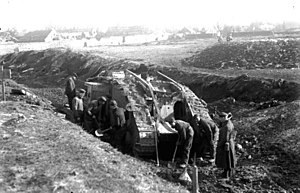
Back Slag van Cambrai Afrikaans معركة كامبريه Arabic Kambre döyüşü (1917) Azerbaijani Бітва пры Камбрэ (1917) Byelorussian Бітва пры Камбрэ (1917) BE-X-OLD Битка при Камбре Bulgarian Batalla de Cambrai (1917) Catalan Bitva u Cambrai Czech Slaget ved Cambrai Danish Schlacht von Cambrai German
| Battle of Cambrai (1917) | |||||||||
|---|---|---|---|---|---|---|---|---|---|
| Part of the Western Front of the First World War | |||||||||
 German soldiers recovering a British Mark IV tank | |||||||||
| |||||||||
| Belligerents | |||||||||
|
|
| ||||||||
| Commanders and leaders | |||||||||
|
|
| ||||||||
| Strength | |||||||||
|
2 corps 476 tanks (378 combat tanks) | 1 corps | ||||||||
| Casualties and losses | |||||||||
|
75,681 (10,042 killed) 180 tanks | 54,720 (8,817 killed) | ||||||||
The Battle of Cambrai (Battle of Cambrai, 1917, First Battle of Cambrai and Schlacht von Cambrai) was a British attack in the First World War, followed by the biggest German counter-attack against the British Expeditionary Force (BEF) since 1914. The town of Cambrai, in the département of Nord, in France, was an important supply centre for the German Siegfriedstellung (known to the British as the Hindenburg Line) and capture of the town and the nearby Bourlon Ridge would threaten the rear of the German line to the north. Major General Henry Tudor, Commander, Royal Artillery (CRA), of the 9th (Scottish) Division, advocated the use of new artillery-infantry tactics on his sector of the front. During preparations, J. F. C. Fuller, a staff officer with the Tank Corps, looked for places to use tanks for raids. General Julian Byng, commander of the Third Army, decided to combine both plans.[a] The French and British armies had used tanks en masse earlier in 1917, although to considerably less effect.[4]
After a big British success on the first day, mechanical unreliability, German artillery and infantry defences exposed the frailties of the Mark IV tank. On the second day, only about half of the tanks were operational and British progress was limited. In the History of the Great War, the British official historian Wilfrid Miles and modern scholars do not place exclusive credit for the first day on tanks but discuss the concurrent evolution of artillery, infantry and tank methods.[5] Numerous developments since 1915 matured at Cambrai, such as predicted artillery fire, sound ranging, infantry infiltration tactics, infantry-tank co-ordination and close air support. The techniques of industrial warfare continued to develop and played a vital part during the Hundred Days Offensive in 1918, along with replacement of the Mark IV tank with improved types. The rapid reinforcement and defence of Bourlon Ridge by the Germans, as well as their counter-attack, were also notable achievements, which gave the Germans hope that an offensive strategy could end the war before American mobilisation became overwhelming.[6]
- ^ "Indian Army on the Western Front". Retrieved 10 August 2020.
- ^ "Newfoundlanders in the Battle of Cambrai, 1917". Retrieved 10 May 2021.
- ^ Harris 1995, p. 62–63.
- ^ Littledale 1918, pp. 836–848.
- ^ Hammond 2009, pp. 429–430.
- ^ Miles 1991, pp. 291, 173–249.
Cite error: There are <ref group=lower-alpha> tags or {{efn}} templates on this page, but the references will not show without a {{reflist|group=lower-alpha}} template or {{notelist}} template (see the help page).